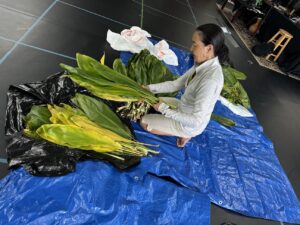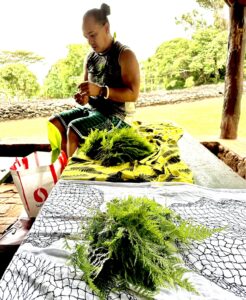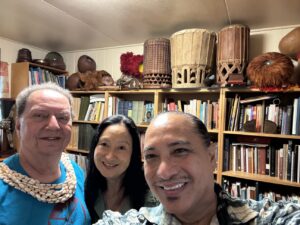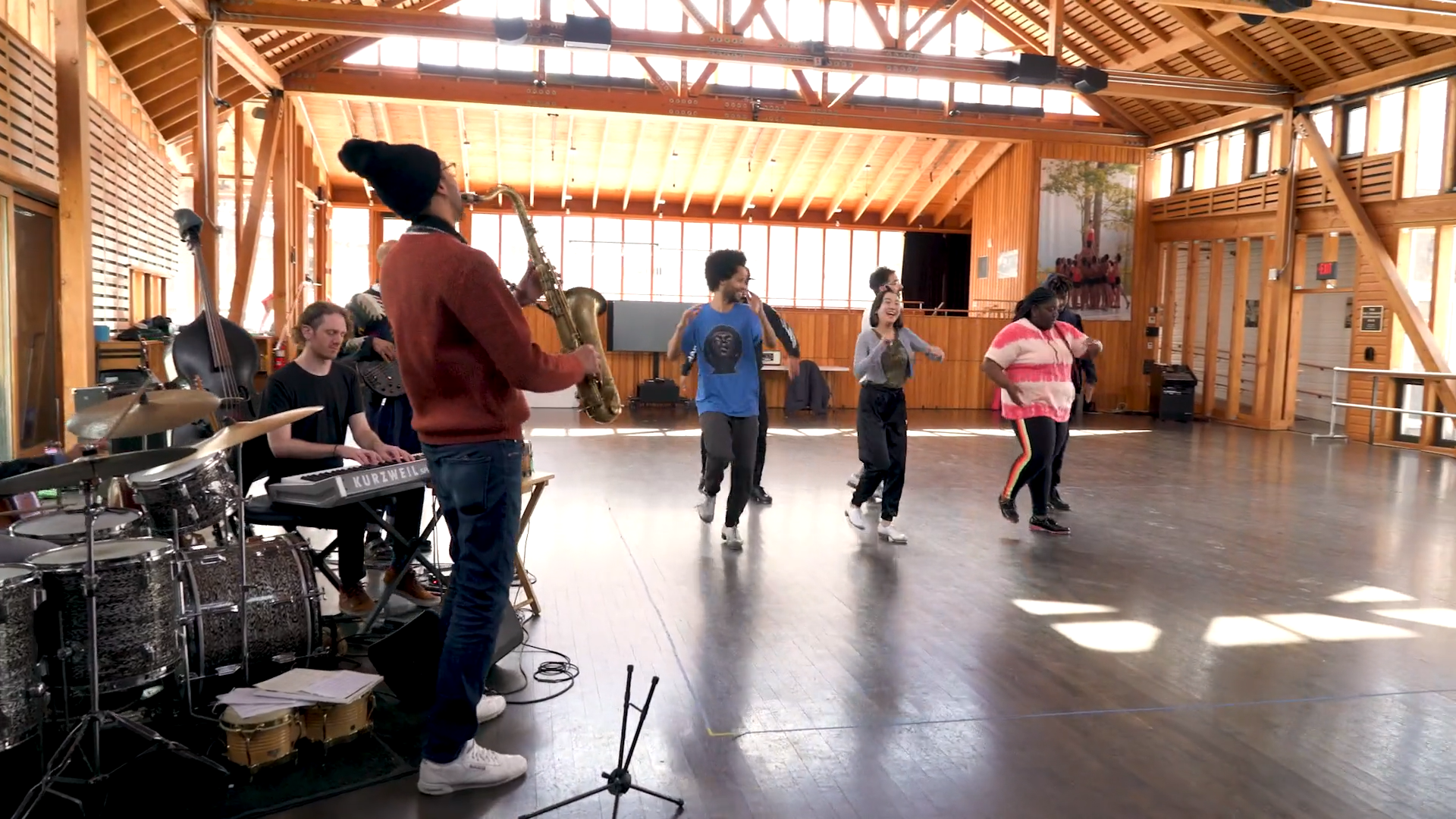About Peter Rockford Espiritu
From February 12-23, 2025, choreographer Peter Rockford Espiritu, a “Kanaka Maoli” (Native Hawaiian) and theater director, and dramaturg Roberta Uno, will investigate embodied archives and deeply rooted memories in the Pillow Lab. Since founding his company Tau Dance Theater on Oʻahu in 1996, Espiritu has pursued a paradigm-shifting movement vision; one that anchors Native Hawaiian and Pacific modalities and technique in conversation with Western dance influences. During this residency, Espiritu will develop Waihona Kino (Body Archive), drawing from his corporeal archive and the deep memories held within. This solo project will be created in collaboration with Roberta Uno, who is a theater director, dramaturg, haumana of Kumu Hula Vicky Holt Takamine, and co-leader of the NYC hālau extension Pua Aliʻi ʻIlima o Nuioka. In anticipation of the residency, Espiritu and Uno discussed artistic legacy and cultural lineage in their work.
What’s inspiring you right now?

PRE: I am starting to focus less on programming performances and shifting towards my life’s legacy, work that builds community through its inclusive interactivity and the messages within the storytelling. Shifting less on ‘brand’ and more on authentic identity. Less on monetizing and more on the artistic and cultural relevance of the story.
RU: I am inspired by this time of hulihia we are in – the turning over, upending, shifting of a transformative era. The earth is crying for our attention. Nationally, this is a time of extreme and polarized positions. And generationally, it’s also a time of transition. Such an important time to reflect and create.
What can audiences expect from your time in the Pillow Lab?
PRE: Ultimately, I aim to have a solid section completed and a map of how we will continue our voyage through my body of work. The laborious task of unpacking decades of work is like cleaning a house and then organizing it so that we can identify what gems we will use to tell this story. The next part is the creation of new work and finding the bridges for transitions that will be the kaula (the cordage) that will bind our canoe together.
RU: We will be looking at where Tauʻs Indigeneity, memories, and teachers are located in his body. I think audiences can expect to experience different genres that anchor him: ballet, modern, hula, etc. He has been fearless in crossing artistic and geographical boundaries, while staying deeply centered spiritually. I think they will experience that spirit.

Is there a piece of advice or wisdom that has stuck with you as an artist?
PRE: I believe that every one of my mentors and ancestors gifted me with a part of their mana (spiritual essence). It feels like ‘The Force’ to me from Star Wars. We also call it Na’au (Guts). I believe if I can open myself and start as an empty vessel, I will be filled with inspiration.
RU: When I was a kid, the choreographer, singer, and theater maker Nobuko Miyamoto told me that being an artist, I would always be like an alien (in the sci-fi sense) to my Japanese American community. She said I would be of the community, but it was also OK to be different. That stuck with me and made me unafraid to go deep inside and also outside boundaries.
How has your cultural background or heritage influenced your work?
PRE: There is no doubt that my work is a direct reflection of my Pacific Island and multi-cultural environment and lineage. The mirror that the work reveals is my upbringing on my mother’s side, Samoan, and my father who is Native Hawaiian. Both grandmothers were pure. Mix that with my hula, ballet and modern dance lineage and you get Tau.
RU: I am a Sansei (third generation Japanese American) born in Hawaiʻi, raised in California, and rooted also on the East Coast. My grandfather was a painter, and my grandparents, parents and larger family were all incarcerated during WWII. Being raised in AAPI culture, and also personally coming to understand the generational trauma of incarceration, I am an artist who wants to reveal and tell the stories that go unseen.
What’s one thing you always have with you in the studio?
PRE: I always start with a traditional Native Hawaiian clearing and protection chant to begin pono (righteousness/balance). Start there and you are free to go where you want.
RU: I always carry a tiny packet of paʻakai (Hawaiian salt) with me. Sometimes to purify and sometimes to gift.
What’s one challenge you’re excited to tackle in your current project?
PRE: It is more like a reawakening of old and new talents. As I traverse the mountain of work I have performed and created I start to realize the epic weight of the gifts I have been given. The challenge is to let go of ego to be able to explore and allow the story to reveal itself, like a sculpture who is starting with a solid block of marble.
RU: I want to tackle the enormity of Tauʻs Waihona Kino – the repository that he holds in his body. The challenge is to do that research with him and distill that artistic lifetime or journey into a well-crafted, embodied evening of performance. Hopefully no longer than an hour and 15 minutes!
Can you describe your artistic journey in three words?
PRE: Leap of faith.
RU: Sprint and marathon.
Is there something you’re currently reading, watching, or listening to that’s influencing your work?
PRE: When I committed to this journey to my body of work, I had to take on a more spiritual awareness to be open to the messages that will help me to understand and ‘Ike (see) possible inspiration. We say Hō’ailona (physical manifestations in nature). Cloud formations, dreams, a bird I have never seen before, a face or shape of a pōhaku (stone).
RU: Aside from everything Tau – I just finished reading James by Percival Everett and admire the reimagining of the story, shifting James to the center of the Huckleberry Finn story. I admired the elegant spareness of the writing and the hulihia of the accepted “beloved” narrative.

Tau and Roberta gathering research, information and blessings for the name of the project with Dr. Puakea Nogelmeier, linguist, composer, Native Hawaiian language scholar and collaborator for many Tau creations; courtesy photo
What’s next for you after your residency at the Pillow Lab?
PRE: We are currently strategizing to finalize the mapping and timeline of moving from (Research & Development) to (Creation) to the ‘world premiere’ of Waihona Kino. We are in discussion with several very exciting collaborations to manifest in 2025-2026.
RU: 2025 is the year we are dedicating to finishing Waihona Kino and touring it, especially to Indigenous settings, both here and internationally. I’m particularly excited to see if this work can retrace Tauʻs journey and be performed in the Pacific Islands.
The challenge is to let go of ego to be able to explore and allow the story to reveal itself, like a sculpture who is starting with a solid block of marble.
What do you hope to take away from your time at Jacob’s Pillow?
PRE: It is my hope that we find our way together to tell the story that deserves to be told in the way that it should be told. How that all comes together is a major goal for this awesome residency. I also hope to connect with the ‘āina (land) and its people past, present and future.
RU: I hope to take away a solid sense of the structure of Waihona Kino and the underpinnings of the final work. On a personal level, I hope the time at Jacob’s Pillow will help me learn to love winter weather (being cold scares me!)

Inside the Pillow Lab is an intimate film series that captures works in process and behind-the-scenes moments of what it’s like for artists to live, work, and rehearse together in residencies on the Pillow’s retreat-like campus.

A year-round incubator of new work, the Pillow Lab hosts ten artist residencies this fall, winter, and spring. Learn more about the dance artists who will be joining the Pillow during crucial development, research, and technical stages of choreography-driven projects.